
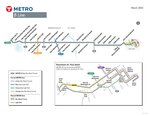
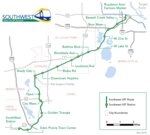


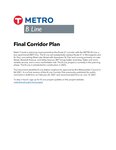





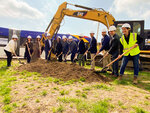

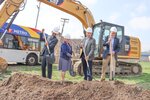








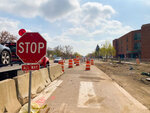

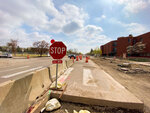







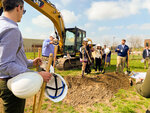



Lake Street will be torn up over the next two summers to create the new 12.6-mile Bus Rapid Transit B Line.
The majority of construction along this line will be done east of Hiawatha this year, and west of Hiawatha next year. The line will open in 2024.
“Riders deserve fast and reliable service, and that is exactly what we are bringing to the B Line corridor through this significant investment,” said Metropolitan Council Chair Charlie Zelle. A groundbreaking for the new line was held at E. Lake and 27th on Monday, May 8, 2023.
The B Line will run every 10 minutes, seven days a week during the day and most of the evening, and will mostly replace Route 21. It aims to make travel time 20% faster along the route.
“It is one of many bus rapid transit lines that we are building throughout the community,” said Zelle, who lives in southwest Minneapolis. “This is not a commuter line. This is a living-your-life-in-the-city line.”
Fellow southwest Minneapolis resident, Senator Tina Smith, stated, “This project is about connecting people to their lives. ... This community is so worthy of this investment.”
“The B Line’s construction is an important step on Lake Street’s road to recovery from the dual impacts of the COVID-19 pandemic and civil unrest,” remarked Lake Street Council Executive Director Allison Sharkey. “The B Line will help more people reach the corridor to experience its cultural and commercial vibrancy while improving service to people who use transit for commuting, shopping and daily life.”
“Expanding public transit is an economic, racial, and climate justice priority. Having the B Line Rapid Transit on Lake Street also represents a significant investment in the East Lake Street corridor recovery after the uprising,” stated Ward 2 Council Member Robin Wonsley.
District 61A Representative Frank Hornstein pointed out that even in the midst of the pandemic, travel along the existing bus rapid transit lines remained stable.
“Transportation is one of the things that – if done right – will create economic prosperity,” said District 61 Senator Scott Dibble.
“This is the line I will be taking to work and this is the line I will be taking home,” observed District 63A Representative Samantha Sencer-Mura.
“The world is on Lake Street and Lake Street is the world,” said District 3 Hennepin County Commissioner Marion Greene. She pointed out that the B Line will connect with others, including the Blue Lightrail Line, Green Lightrail Extension, Orange BRT Line and coming BRT E Line. “Not only can you find the world here on Lake Street, but you can access the world beyond Lake St.”
“I am feeling the energy here,” remarked Ramsey County Commissioner Rena Moran.
The B Line will have about two to three stops per mile. The initial plan called for ending the line at Snelling and University; but the city of St. Paul and other stakeholders requested that it go all the way to downtown St. Paul. Planners also considered whether to route the line through the Midway along University as the Route 21 bus line does now, but ultimately decided upon Selby instead.
St. Paul Mayor Melvin Carter shared that for his first job after college, he took the bus along Selby Ave. He still remembers the people he saw daily on the bus, and the sense of community he felt. If he missed a day, “my day would be off because I didn’t get a chance to do my morning routine with the people on the bus,” he recalled. “One of the things we don’t talk about enough is the amount of community building that happens on the train or bus.”
“It’s not about the buses,” agreed Zelle. “It’s about the community inside the buses.”
More than 30 stations will be built between Union Depot in St. Paul and the Uptown area of Minneapolis. In Minneapolis, stations will be at West Lake St. (connecting to the Green Line lightrail), Lagoon and East Bde Mada Ska, Lagoon and Hennepin, Lyndale, Nicollet, Interstate 35W, 4th/5th, Chicago, Bloomington, Cedar, Midtown, Minnehaha, 31st, 36th and 44th. In St. Paul, they will be at Marshall and Otis, Cretin, Cleveland, and Fairview; Snelling and Dayton; Selby and Hamline, Lexington, Victoria, Dale, and Western-Arundel; John Ireland and Marshall; and six locations in downtown St. Paul before ending at Union Depot.
Stations for BRT lines are not in turn lanes or parking lanes like other bus routes. Instead, they are in traffic lanes, which eliminate buses merging in and out of traffic.
Bus-only lanes will be implemented on portions of Lake Street, Lagoon Avenue and Marshall Avenue.
The first BRT line to operate is the A Line that begins at the 46th and Hiawatha lightrail station (Blue Line), proceeds across the Mississippi River into St. Paul and then follows Snelling Ave. up to Rosedale Mall in Roseville.
“The new B Line will make it easier for Saint Paul residents to get to work, school and recreation by increasing service and reducing travel times. Efficient transit is key to reducing the emissions that contribute to climate change. The new B Line is a win-win for our community,” said Russ Stark, chief resilience officer for the city of Saint Paul.
562,000 rides in four months
In the first four months of 2023, there were 562,000 rides on the 21, pointed out Minneapolis Mayor Jacob Frey. “It is the most ridden line in the city.” He added, “When you have a diversity of transportation options, more and more people will decide to take that trip.”
Four open houses were held in 2019 to solicit community feedback, at South High and Walker Library in Minneapolis, and Merriam Park Library and Oxford Community Center in St. Paul. Additional meetings were held along Selby Ave. in St. Paul in the summer of 2019. Over the next few years, Metro Transit used postcards, flyers at bus stops, limited in-person conversations, emails to subscribers, and targeted social media posts. About 660 comments were submitted on the draft plan, and approximately 160 comments were submitted on the recommended plan.
The B Line will use 60-foot “articulated” buses with wider aisles, more seating capacity, and additional doors.
A fiber optic network will be built along the length of the whole corridor to link technology at stations.
Pedestrian and signal improvements will be constructed at an additional 50+ intersections.
Lake Street and Lagoon Avenue will be resurfaced to improve pavement conditions.
In Minneapolis, construction will be staged to allow two-way traffic flow on Lake Street at all times, as well as allow traffic flow in the Lake and Lagoon sections of Uptown.
In St. Paul, construction on Marshall Avenue will be staged to allow two-way traffic flow at all times. On Selby Avenue, intersections will be fully closed to auto traffic for about a month with additional lane restrictions for longer time periods.
There will be bus detours during construction.
Construction is being coordinated with other projects in the area:
• The B Line will serve stations in downtown St. Paul that will be constructed in 2023 and 2024 as part of the METRO Gold Line project.
• Stations at Lake & Nicollet, I-35W & Lake, and Lake & 4th/5th Avenue were mostly constructed as part of the METRO Orange Line project in 2020-2021.
• Stations at Lake Street / Midtown Station are being constructed through coordination with Hennepin County’s Hi-Lake Improvements project in 2024.
The B Line is fully funded through a mix of federal, state, and Metropolitan Council funds. The estimated cost of the project is $65 million.
Local bus service on Route 21 will continue to run every 30 minutes along Lake St. between Hennepin Ave. and Minnehaha Ave. A new route 60 will run every 30 minutes in St. Paul to connect Selby Ave. with the Midway area and the State Capitol area. Changes to Route 53 along I-94 will be evaluated as the B Line approaches implementation.
Sign up for construction updates at www.metrotransit.org/b-line-project.
“This doesn’t stop here,” said Frey. “When you think about Lake St., not only is it an important corridor but it is going to shine. Let’s keep the momentum going.”
Comments
No comments on this item Please log in to comment by clicking here